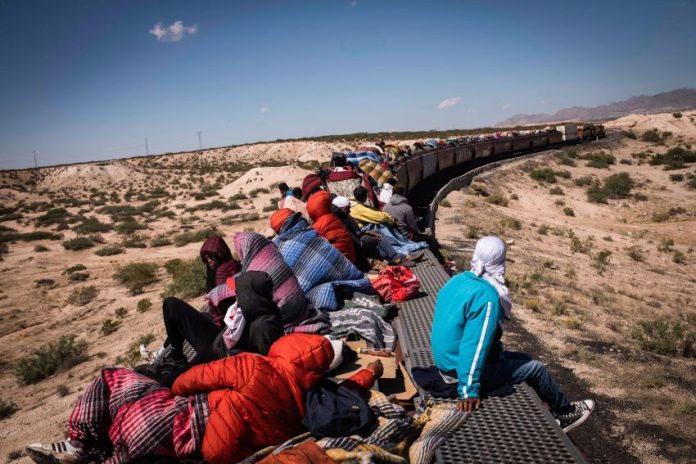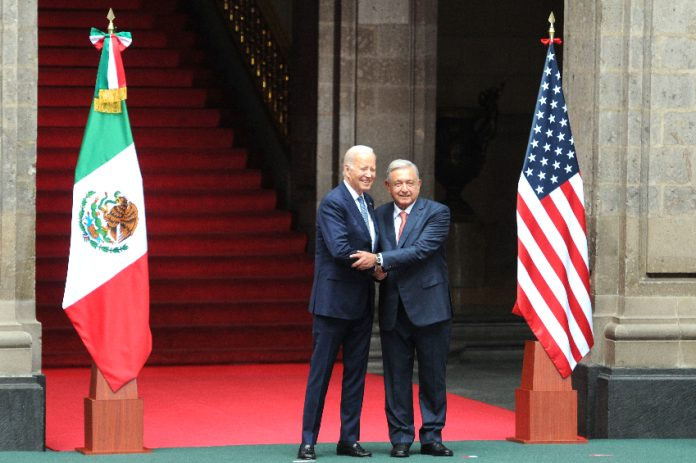by Mexico News Daily
President Andrés Manuel López Obrador and United States President Joe Biden agreed on Thursday that “additional enforcement actions” to stem the flow of migrants are needed before currently closed border crossings can reopen, according to White House spokesman John Kirby.
The two presidents spoke by telephone three days after U.S. Customs and Border Protection (CBP) closed international railway crossing bridges in Eagle Pass and El Paso, Texas, “in order to redirect personnel to assist the U.S. Border Patrol with taking migrants into custody.”

Kirby, spokesman for the White House National Security Council, told reporters that the “two leaders agreed that additional enforcement actions are urgently needed so that key ports of entry can be reopened across our shared border.”
He also said that a delegation of U.S. officials including Secretary of State Antony Blinken, Homeland Security Secretary Alejandro Mayorkas and U.S. Homeland Security adviser Elizabeth Sherwood-Randall would travel to Mexico in the coming days to discuss the migration issue with López Obrador.
“Their visit will really be about getting at the migratory flows and talking to President López Obrador and his team about what more we can do together,” Kirby said. “There’s probably more we can be doing.”
CBP has recently closed other border crossings including the Lukeville Port of Entry in Arizona, which remains out of action.
Organizations including top Mexican farm lobby CNA and the Mexican Employers Federation have expressed their dissatisfaction with the rail bridge closures, pointing out that they will cause significant economic losses.
Rail freight operator Union Pacific cited a figure of US $200 million per day, and asserted that “during this massive [migration] surge only 5 people have attempted to come into the U.S. on Union Pacific trains in the last 5 weeks.”
For its part, the CBP said it had observed “a recent resurgence of smuggling organizations moving migrants through Mexico via freight trains” and announced it was “taking additional actions to surge personnel and address this concerning development, including in partnership with Mexican authorities.”
The Associated Press reported that “migrants often ride freight trains through Mexico, hopping off just before entering the U.S.”
The CBP’s decision to suspend operations at the two rail bridges came after a period during which large numbers of migrants had crossed into Texas, where Governor Greg Abbott signed into law on Monday what his government called “a transformative package of border security legislation.”
One law set to take effect in March “creates a criminal offense for illegal entry into this state from a foreign nation,” according to a Texas government statement.
López Obrador called the law “inhumane” and said Mexico would challenge it.
He also spoke to Biden about migration during a meeting in San Francisco last month.
At the time, López Obrador said that further progress needs to be made on the migration issue, but noted that the two countries were working together on the issue.
He also thanked Biden for the legal migration pathways his administration has opened up for citizens of certain Western Hemisphere countries and acknowledged that his administration hadn’t built any additional wall on the Mexico-U.S border – at least not yet.
Biden thanked López Obrador for his “cooperation” and “leadership” on the migration “challenge,” telling his counterpart that he knew such work was not easy.
“We’re taking a balanced approach that lies at the heart of the Los Angeles Declaration on Migration and Protection. … It includes enforcing our borders … and opening a historic number of legal pathways for migrants,” he said.
Migration is a key focus of the bilateral relationship between Mexico and the United States, and the amount of attention the issue gets is only going to increase as both nations head into an election year, and large numbers of people continue to seek a better life in the U.S.
CBP encountered a record high of almost 2.5 million migrants at the U.S.-Mexico border in fiscal year 2023, which ended in September, while “December 2023 has so far seen some of the heaviest arrivals ever of migrants, mostly asylum seekers, at the … border,” according to the Washington Office on Latin America.



